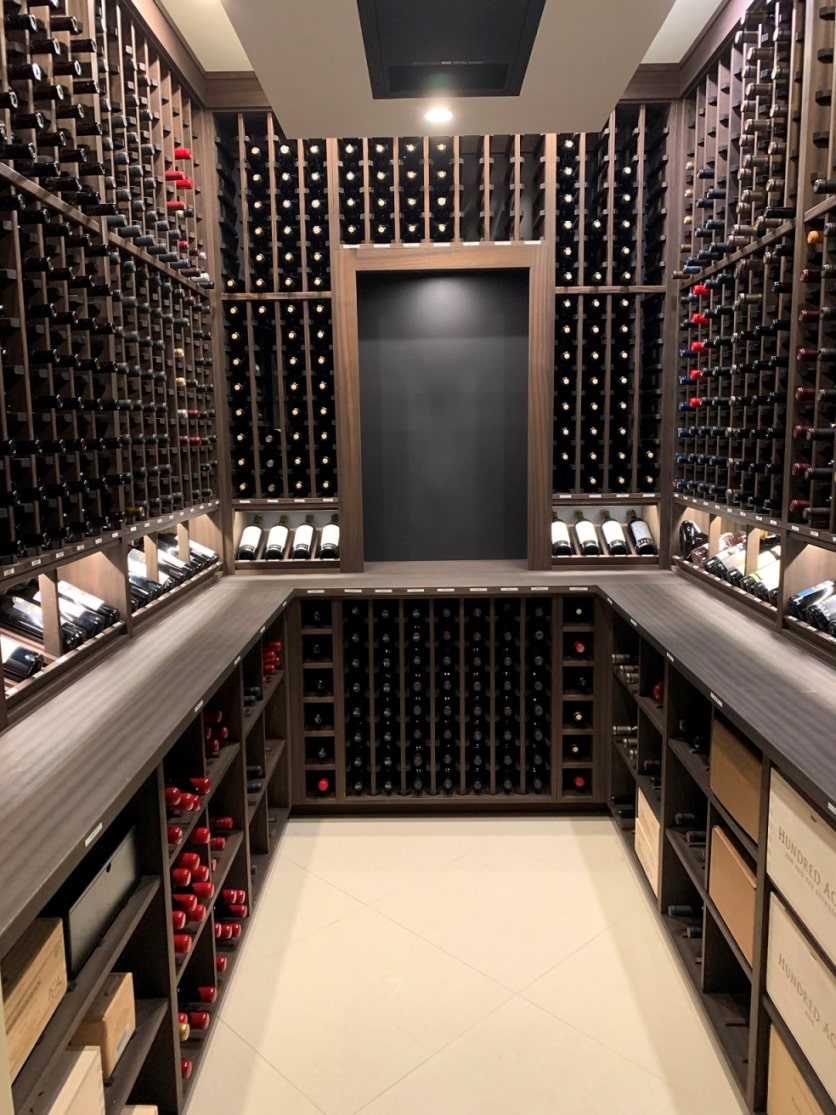How We Approach the Wine Cellar Design Process
This article is an in-depth look at how the Harvest team approaches the wine cellar design process for homeowners wanting to add wine storage to their residence. You can learn more about this incredible transitional home Maryland wine cellar here.
Are you excited to start the wine cellar design process for your dream wine cellar? As with all large undertakings, it starts with careful planning. But how does the wine cellar design process actually work? Let’s take a look at the steps Tim Wright, a wine cellar design expert with Harvest Custom Wine Cellars and Saunas, took in designing this wine cellar for a couple in Maryland.

First Step of the Wine Cellar Design Process: Visit the Client’s Home or Business Establishment
A visit to the client’s home or business is a very important step of the wine cellar design process. The main purpose of the team for doing this is to assess the dimensions of the proposed space for the wine cellar, taking note of the important information that will be used for heat load calculation, and getting a first-hand look at the stylistic preferences of the client.
For this Maryland wine cellar project, Tim and his team visited the client’s home to discuss how the process will proceed from start to finish. So, as mentioned above, the team recorded all the needed information for the project. Tim also asked relevant questions that would be helpful while designing and building the wine room.
The husband originally wanted a more contemporary design for their home wine cellar, but his wife was interested in a more traditional wine cellar style. The wife also sent photos of wine cellars she found online. The photos she shared leaned more towards the traditional wine cellar design where wooden racks are very prevalent.
After discussing the different design inspirations, Tim found some additional photos to help clarify their vision and decide on a course of action. After reviewing Tim’s recommendations and discussing some images provided by Kessick, they decided to incorporate their ideas into a transitional design style.
Second Step: The Team Creates an Overall Project Plan and Discusses It with Client
Tim shared all the information he got after his initial visit with his team. He worked with the architect the homeowners hired to create a suitable wine cellar design for the project. The architect started designing the space while also considering the cooling system that Tim selected for installation. The architect created a blueprint that Tim could refer to, and then Tim had a final design rendering created. With all the essential data taken into account, a wine cellar design was done. Then, Tim presented the plan to the client.
Creating a wine cellar design plan for a wine cellar project doesn’t happen overnight. It must be carefully prepared until the client’s ideal wine cellar is drawn accurately. At the same time, the final wine cellar design must be functional when built. You’ll start to see all the benefits of the effort and time invested during planning once the construction of the wine cellar has started.
After the Wine Cellar Design Process, Construction of the Wine Cellar Can Commence

Once the final plan was agreed upon, Tim and his team of wine cellar design experts went on to build the wine cellar. The dimension of the wine room is 111 inches by 92.5 inches. Amazingly, this small wine cellar could house 1650 wine bottles! The meticulous wine cellar design process behind this Maryland project did pay off.
Moving on to the construction of the wine cellar. There’s one small obstacle that the team had to tackle. Beside the proposed wine room is a boiler room. This could’ve tremendously affected the cooling process inside the wine cellar if it was ignored. The team installed an R13 spray foam application between the wall cavities to help insulate the wine cellar from external temperature changes. With this installed, the owner could be assured that the heat coming from the boiler room won’t disturb the optimum wine temperature and humidity that will be maintained in the wine room.
With the heat load calculated, Tim suggested that the best option for their wine cellar would be a ceiling-mount split type cooling unit from Wine Guardian. This cooling system is perfect for a wine cellar this size since it occupies minimal space in the wine cellar. After installation, the only part visible is the ceiling-mounted vent pushing cool air inside. Split cooling systems are ducted to eliminate the noise coming from their components.
For the wine racking system, the team installed rectangular wooden wine racks made of Sapele Mahogany. Even though the wooden elements appear to give this wine cellar a traditional style, the abundance of clean, straight lines and angles in the racking system gives it a more contemporary feel. Overall, it is a transitional wine cellar design where both traditional and modern wine cellar elements intermingle. The team added cross members to the default racking system to maximize the wine capacity of the wine cellar. And the lower part of the racking system was built with open bins to contain wine cases.
Trust the Wine Cellar Design Process: Hire Professionals to Do the Job

The wine cellar design process can be the longest phase for building your custom wine cellar, but it will be worth it in the long run. A properly planned wine cellar translates to less expenses for premature repairs in the future. Over time you’ll see that it is an investment that would help keep your wine cellar in tiptop shape for the longest time possible. And as your personal investment, it is both sound and reasonable to hire wine room design experts like Tim from Harvest Custom Wine Cellars and Saunas. Trust the process and we’ll do the rest. Call us NOW!



